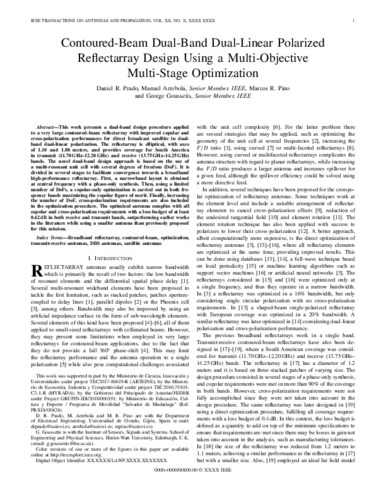Contoured-Beam Dual-Band Dual-Linear Polarized Reflectarray Design Using a Multi-Objective Multi-Stage Optimization
Autor(es) y otros:
Palabra(s) clave:
broadband reflectarray
contoured-beam
optimization
transmit-receive antennas
DBS antennas
satellite antennas
Fecha de publicación:
Editorial:
IEEE
Versión del editor:
Citación:
Descripción física:
Resumen:
This work presents a dual-band design procedure applied to a very large contoured-beam reflectarray with improved copolar and cross-polarization performances for direct broadcast satellite in dual-band dual-linear polarization. The reflectarray is elliptical, with axes of 1.10 and 1.08 meters, and provides coverage for South America in transmit (11.70 GHz–12.20 GHz) and receive (13.75 GHz–14.25 GHz) bands. The novel dual-band design approach is based on the use of a multi-resonant unit cell with several degrees of freedom (DoF). It is divided in several stages to facilitate convergence towards a broadband high-performance reflectarray. First, a narrowband layout is obtained at central frequency with a phase-only synthesis. Then, using a limited number of DoFs, a copolar-only optimization is carried out in both frequency bands maximizing the copolar figure of merit. Finally, increasing the number of DoF, cross-polarization requirements are also included in the optimization procedure. The optimized antenna complies with all copolar and cross-polarization requirements with a loss budget of at least 0.62 dB in both receive and transmit bands, outperforming earlier works in the literature while using a smaller antenna than previously proposed for this mission.
This work presents a dual-band design procedure applied to a very large contoured-beam reflectarray with improved copolar and cross-polarization performances for direct broadcast satellite in dual-band dual-linear polarization. The reflectarray is elliptical, with axes of 1.10 and 1.08 meters, and provides coverage for South America in transmit (11.70 GHz–12.20 GHz) and receive (13.75 GHz–14.25 GHz) bands. The novel dual-band design approach is based on the use of a multi-resonant unit cell with several degrees of freedom (DoF). It is divided in several stages to facilitate convergence towards a broadband high-performance reflectarray. First, a narrowband layout is obtained at central frequency with a phase-only synthesis. Then, using a limited number of DoFs, a copolar-only optimization is carried out in both frequency bands maximizing the copolar figure of merit. Finally, increasing the number of DoF, cross-polarization requirements are also included in the optimization procedure. The optimized antenna complies with all copolar and cross-polarization requirements with a loss budget of at least 0.62 dB in both receive and transmit bands, outperforming earlier works in the literature while using a smaller antenna than previously proposed for this mission.
Patrocinado por:
This work was supported in part by the Ministerio de Ciencia, Innovación y Universidades under project TEC2017-86619-R (ARTEINE); by the Ministerio de Economía, Industria y Competitividad under project TEC2016-75103-C2-1-R (MYRADA); by the Gobierno del Principado de Asturias/FEDER under Project GRUPIN-IDI/2018/000191; by Ministerio de Educación, Cultura y Deporte / Programa de Movilidad “Salvador de Madariaga” (Ref. PRX18/00424).
Colecciones
Ficheros en el ítem





